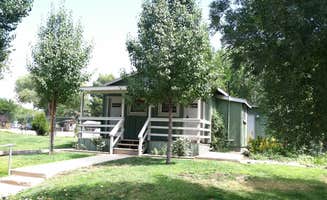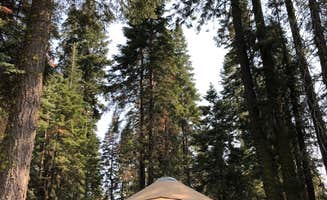Yurt camping in Posey, California provides access to camping elevations around 6,500 feet in the Sequoia National Forest. River access varies seasonally with water levels typically highest from May through June and dropping significantly by August. Winter temperatures regularly drop below freezing, limiting access to many campgrounds that operate only from late spring through early fall.
What to do
River tubing: Float the Kern River at KRS RV Resort@Camp James, where small creeks running through the campground create additional opportunities for water activities. "We stayed in site 81 in our class C RV. Corner site on a creek that ran through the campground. The creek was great to sit in to escape the heat and float down," reports David H.
Sequoia viewing: Visit nearby groves at Quaking Aspen Campground which offers direct access to several hiking trails among giant trees. "It is just a short (very steep) hike from The Wheel Meadow Grove of Giant Sequoias. The trail going from the campground down to the trees is a great Mtn Biking trail. Loads of turns and beautiful views," according to Hayley K.
Fishing: Cast for trout in multiple locations along the Kern River watershed. "I have also caught tons of trout here so fishing is excellent!" shares Tyler C. about his experiences at Springhill South Recreation Site. Areas near Kernville provide some of the most reliable fishing spots with seasonal changes in water levels affecting catch rates.
What campers like
Riverside sites: Waterfront camping at Headquarters Campground provides immediate river access. "By far the best campground there. The river front campsites are awesome and have a great size. There's plenty of shade (which is rare for the area), and the section of river is so fun," explains Morgan F.
Seasonal peace: Fall visits offer significantly reduced crowds at several campgrounds. "We stayed here in October after the yurts had been taken down which was no bother to us when you're surrounded by the most magnificent trees in the world! This also meant there were no crowds and we had practically the entire campground to ourselves," notes Lili R. about her fall experience at Camp Three Campground.
Temperature relief: Riverside locations provide natural cooling during hot summer days. "Once you get down to the water, the temperature drops at least 10 degrees," explains Haley M. about Hospital Flat. Many campers mention the temperature differential between campsites and the river's edge, making riverside activities particularly valuable during July and August heat.
What you should know
Facility limitations: No potable water at several campgrounds requires advance planning. "The campground host never came around and it felt like we could have stayed for free. We had some questions about the area and in order to get some answers we had to drive to the nearest people," writes Amanda B. about Quaking Aspen Campground, highlighting the self-sufficient nature of camping here.
Bear preparedness: Limited bear boxes at group sites requires food storage planning. "My only complaint was that there was only one normal sized bear locker for a group campsite. Hard to fit coolers and food for 15 people into one bear locker," warns Lauren S. about Quaking Aspen Campground.
Cell service: Limited connectivity affects most campgrounds in the area. "No service within the campground so make sure you have everything available to you," advises Josh S. Several campgrounds mention that the Camp Nelson general store and Kernville provide limited WiFi access points when needed.
Tips for camping with families
Creek play: Look for sites with small water features that provide safer alternatives to the main river. "The kids loved tubing down it all day. In front of us was the river. Gorgeous views. The grounds are very well maintained, they collect trash every morning," shares Amber D. about Camp James.
Structured activities: Some campgrounds offer organized events for children during peak season. "This campground even offers activities for the whole family, movie night, bingo, even rock painting," notes Amber D. about Camp James, making it particularly suitable for families with young children.
Water safety: Prepare for strong currents in the main river channel. "This river is notorious for sweeping people away so please be cautious and keep an eye on your children. We secured a paracord on each end of the river so we had something to help us float across," advises Haley M. about Hospital Flat.
Tips from RVers
Site selection: Choose carefully for larger rigs as many sites have limitations. "Camp sights are very close to one another not much privacy. The RV sights with full hooks up are further away from the river about 200 yards," explains Jeff G. about Camp James, highlighting the common tradeoff between hookups and river proximity.
Road navigation: Narrow access roads limit larger RVs at several campgrounds. "I do not recommend anything bigger than 24 feet or so. The road through the campground is very narrow, and lined with large boulders. Some of the turns are very tight," warns Tricia V. about Hospital Flat.
Extended stays: Plan for dump station access which is limited in the area. "There is a dump station in the campground," notes David H. about Camp James, one of the few facilities offering this service, making it suitable for longer stays in self-contained RVs.




